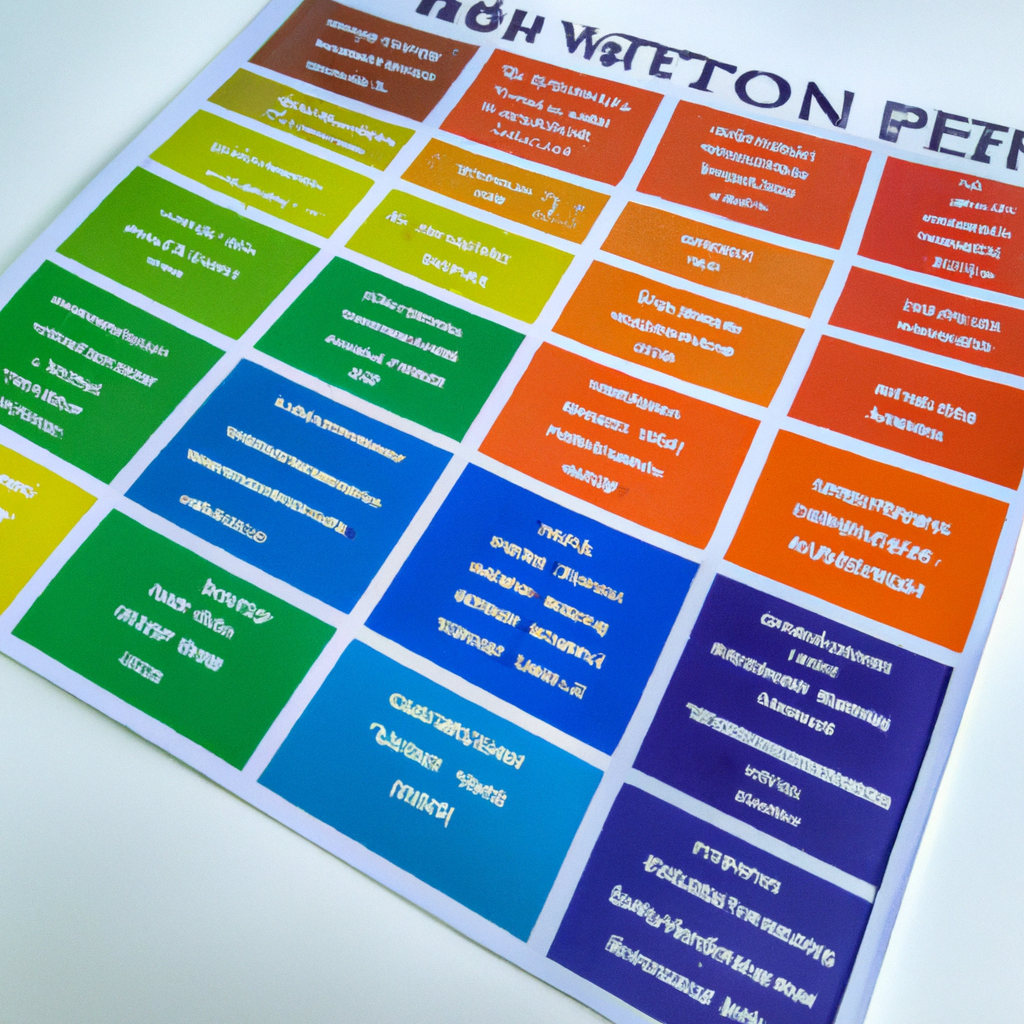Introduction: Explain why a balanced diet is important for one’s overall health and wellness.
Creating a balanced diet plan is essential for optimizing your overall health and wellness. Eating a balanced diet is one of the cornerstones of good health, and there are numerous benefits that go along with it. Eating a balanced diet can help reduce the risk of chronic diseases, provide the body with essential nutrients and help maintain a healthy weight.
A balanced diet is one that contains the right proportions of carbohydrates, fats, proteins, vitamins, and minerals. Eating a variety of foods from each food group is essential for proper nutrition. Fruits and vegetables are important sources of vitamins and minerals, while whole grains and low-fat dairy products provide carbohydrates and protein. Healthy fats from sources like nuts and fish should also be incorporated.
Having a balanced diet can also help prevent certain health problems, such as osteoporosis, heart disease, and diabetes. Eating a balanced diet can also help reduce the risk of certain cancers and improve mental health.
Creating a balanced diet plan involves eating a variety of foods from each food group and ensuring that you are getting the right balance of nutrients. It’s important to make sure your meals are varied and contain different sources of proteins, carbohydrates, and healthy fats. It’s also important to limit processed foods and sugary drinks, as well as to ensure you are getting enough fiber and water in your diet.
Overall, creating a balanced diet plan is essential for optimal health and wellness. Eating a variety of foods from each food group, limiting processed foods and sugary drinks, and incorporating healthy fats can help you create a healthy, balanced diet plan for life.
Step 1: Discuss the key components of a balanced diet and why each should be included.
When it comes to creating a balanced diet plan to promote overall health and wellness, it’s important to understand the key components that should be included. A balanced diet is composed of a variety of nutrient-rich food groups that provide your body with the energy, necessary vitamins and minerals, and other essential nutrients it needs. Here are the key components to include in your diet plan:
Fruits and Vegetables: Fruits and vegetables provide essential vitamins, minerals, and fiber. Eating a variety of these foods can help you stay healthy, as they are low in calories and are packed with antioxidants.
Whole Grains: Whole grain foods, such as brown rice, oats, and quinoa, are rich sources of fiber, vitamins, minerals, and other nutrients that your body needs. Eating whole grains can help keep your cholesterol levels in check and can help reduce your risk for certain diseases.
Lean Protein: Lean proteins, such as skinless chicken, fish, tofu, and legumes, are excellent sources of amino acids, which are the building blocks for protein. Eating a variety of lean proteins can help to keep your metabolism up and help keep you feeling fuller for longer.
Dairy: Dairy like milk, cheese, and yogurt are rich in nutrients, such as calcium, phosphorus, and vitamin B12. Eating low-fat dairy can help strengthen bones, minimize cravings, and, when combined with regular exercise, can help with weight loss.
Healthy Fats: Healthy fats, such as olive and canola oils, avocados, and nuts are essential for hormone and brain development, as well as aiding in the absorption of vitamins. Healthy fats can also help boost immunity and guard against diseases such as heart disease and stroke.
These five components form the base of a balanced diet, which should be complemented with an active lifestyle and adequate hydration throughout the day. Include these five key components in your diet plan to promote overall health and wellness.
Step 2: Describe how to determine calorie needs and how to track food intake.
Creating a balanced diet plan is essential for overall health and wellness. Knowing how to accurately determine your own calorie needs and tracking your food intake can go a long way in helping you reach your health and wellness goals.
To accurately determine your own calorie needs, consider your age, height, weight and activity level. You can use a calorie calculator online to get a rough estimate of what your daily calorie needs are. Make sure to tailor your exercise and food intake to your goals. If your goal is weight loss, you will want to aim for a lower daily calorie intake. If your goal is weight gain, you will want to aim for a higher daily calorie intake.
After you know your estimated daily calorie needs, you can use a food diary or calorie tracking app to record your food intake. Log all meals, snacks, and drinks and make sure you’re staying within your calorie goals. Keep track of not just the food you eat but also portion sizes, timings, and nutrient content. This is where understanding what makes up a balanced meal can be helpful. Aim to include fruits, vegetables, whole grains, low-fat dairy, lean proteins, and healthy fats into your meals and snacks.
A balanced diet plan can help you look and feel your best and maintain your overall health and wellness. Once you know your calorie needs and track your food intake, you will be on your way to reaching your goals.
Step 3: Explain the importance of meal planning and list healthy ingredients for balanced meals.
Meal planning is an important part of creating a balanced diet plan. Taking the time to plan out meals, snacks, and desserts gives you an idea of what your daily nutrition will look like and helps you make sure your diet is healthy and balanced. Planning meals ahead of time also ensures that you have access to nutritious ingredients when you need them.
When creating meals, it is important to focus on eating a balanced combination of foods. Healthy ingredients include proteins, like lean meats and plant-based proteins, whole grains, colorful fruits and vegetables, low-fat dairy products, and healthy fats. Meats should be lean, such as skinless chicken, lean beef, and fish. Whole grains like quinoa, oats, and brown rice should make up the majority of your carbohydrates. Fruits and vegetables should be varied, with a focus on fresh items when possible. Low-fat dairy products like milk and yogurt are important for healthy bones and teeth, and healthy fats like olives, avocados, nuts, and seeds can increase nutrient absorption for their essential vitamins and minerals.
Meal planning helps you create meals using these nutritious ingredients. It allows you to be mindful of your portion sizes, so that you can meet your health and wellness goals. Meal planning can also help to reduce stress, because you don’t have to worry about what to eat each day. When you plan meals and snacks ahead of time, it’s easier to stick to the healthy habits you set.
By taking the time to plan healthy meals, you can ensure that you are getting the nutrition you need to achieve your health and wellness goals. Eating a balanced diet with a variety of nutrient-dense ingredients can help to keep you feeling your best.
Step 4: Walk through the steps for creating a personalized balanced diet plan and share tips for sticking to it.
Most people know that having a balanced diet is important for overall health and wellness. But with so many diets on the market, it can be hard to decide which one is right for you. That’s why it’s important to create a personalized balanced diet plan that works for your lifestyle and calorie needs. Here’s a step-by-step guide on how to create a balanced diet plan that’s perfect for you.
Step 1: Calculate Your Calorie Needs
Before you begin planning your balanced diet, it’s important to figure out your daily caloric needs. You can use a calorie calculator to figure out how many calories you should be consuming each day. Be sure to consider your lifestyle, activity level, and any weight goals/loss you might have.
Step 2: Break It Up by Macros
Once you’ve established how many calories you should consume on a daily basis, you can now break it up by macros. This means that you’ll need to divide those calories into protein, carbs, and fat. Aim to get the majority of your calories from a balanced combination of the three macro groups.
Step 3: Balance Your Food
Now that you know the total number of calories you should consume each day and how to break them up by macros, it’s time to choose the actual food. Create a meal plan that is balanced, contains a variety of different foods, and gets you to your macro goals. Incorporate more fruits and vegetables, whole grains, protein sources, and low-fat dairy.
Step 4: Walk through the Steps for Creating a Personalized Balanced Diet Plan and Share Tips for Sticking to It
Now that you’ve created your personalized balanced diet plan, it’s important to stick to it. Here are some tips to help ensure you stay on track:
• Plan out your meals and snacks in advance.
• Eat slowly and make sure to chew your food thoroughly.
• Avoid emotional eating and prevent boredom by finding healthy activities to fill your time.
• Don’t forget about portion control – make sure you’re not overeating.
• Drink plenty of water throughout the day to stay hydrated.
• Exercise regularly as part of your daily routine.
Creating a personalized balanced diet plan and sticking to it can be difficult. But with a little bit of effort, you can make sure you’re eating a balanced diet that’s tailored to your individual needs. You’ll be well on your way to achieving your health and wellness goals!





